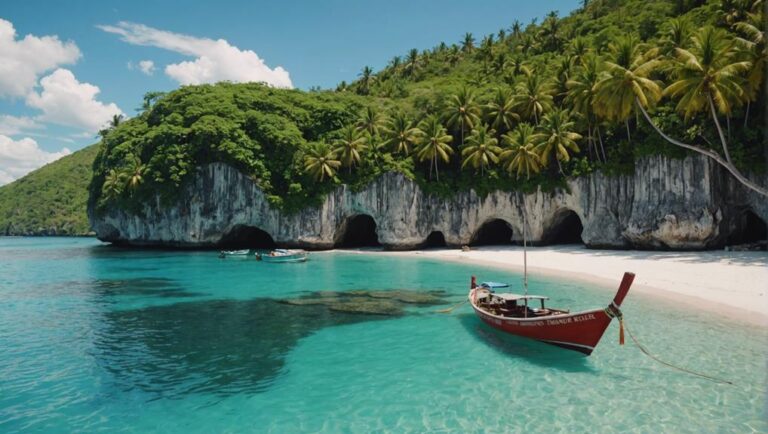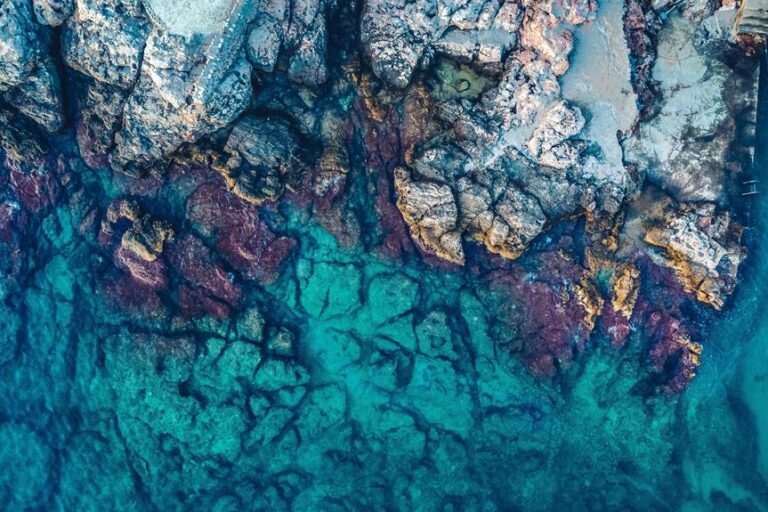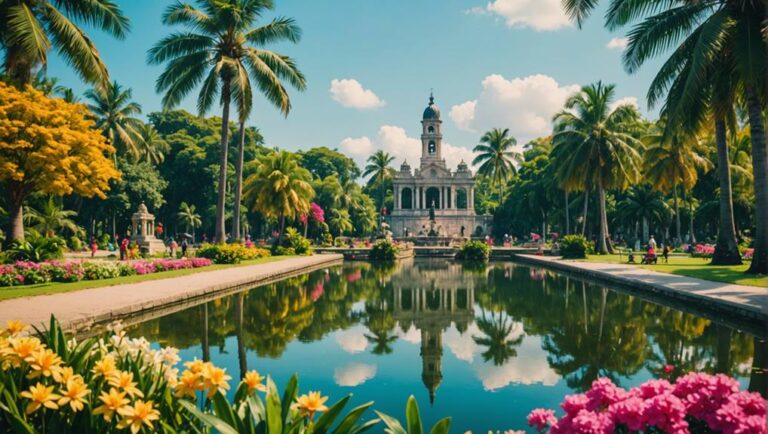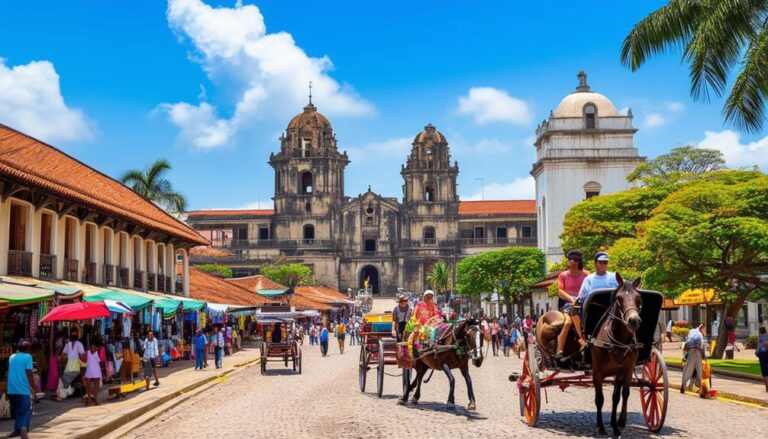Exploring Sagada: A Guide to the Philippines' Hidden Gem
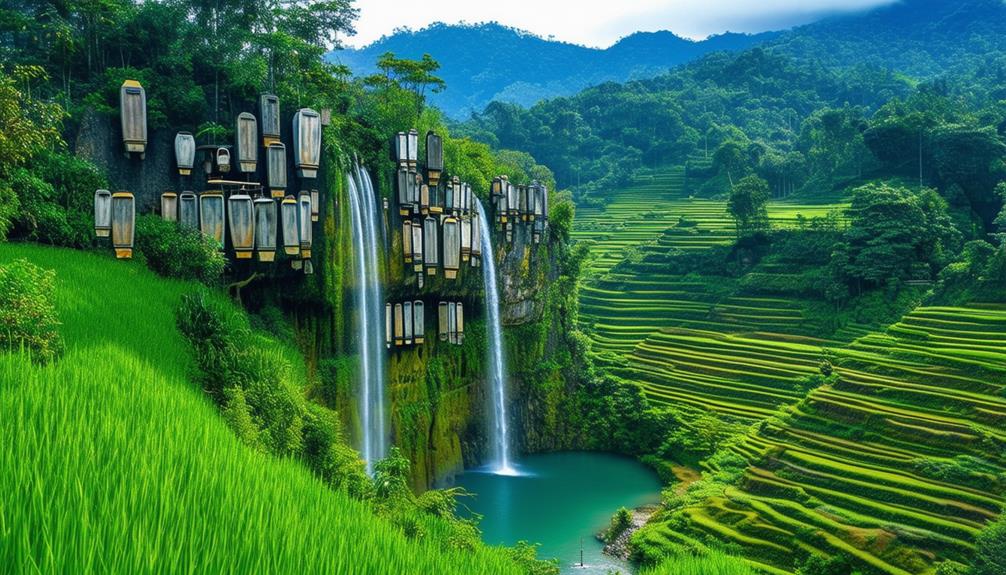
Discover Sagada, a hidden gem in the Philippines’ Cordillera region, where history and nature converge in breathtaking harmony. Walk amidst limestone cliffs and lush valleys, explore historic hanging coffins in Echo Valley, and take in the cool subtropical highland climate.
Enjoy the adventure tracking at Sumaguing Cave or hike to the majestic Bomod-ok Falls. Enjoy local delicacies like pinikpikan and etag. Sagada’s rich culture shines through traditional crafts and the Episcopal Church’s legacy.
Whether you’re an adventurer or a cultural enthusiast, Sagada promises enchantment at every turn. Explore further to uncover more wonders waiting for you.
Key Takeaways
- Discover Sagada’s traditional hanging coffins in Echo Valley, a unique and ancient burial practice.
- Adventure through Sumaguing Cave and Lumiang Cave for thrilling spelunking and cave exploration experiences.
- Visit Bomod-ok Falls for a refreshing hike and stunning natural scenery.
- Experience local culture by attending festivals, participating in workshops, and sampling indigenous cuisines like pinikpikan and etag.
- Stay in local guesthouses to support the community and enjoy authentic Sagada hospitality.
Here’s a detailed table about “Exploring Sagada”:
| Section | Description |
|---|---|
| Location | Sagada is a municipality in the Mountain Province, located in the Cordillera Administrative Region of the Philippines. It sits at an elevation of around 1,500 meters (4,900 feet) above sea level in the Cordillera Central mountain range. |
| Getting There | Sagada is approximately 7-8 hours by bus or car from Baguio City, the summer capital of the Philippines. It can also be reached from Banaue, which is around 4 hours away by car or van. |
| Best Time to Visit | The best time to visit Sagada is during the dry season, which runs from November to May. The weather is generally cool and pleasant, with temperatures ranging from 10°C to 25°C (50°F to 77°F). |
| Attractions | 1. Hanging Coffins: Sagada is famous for its unique burial practice of hanging coffins on cliffs and cave walls. Visitors can hike to see these ancient coffins up close. 2. Sumaguing Cave: This extensive cave system features impressive rock formations, underground rivers, and ancient burial sites. 3. Bomod-ok Falls: A series of cascading waterfalls surrounded by lush greenery, perfect for hiking and picnicking. 4. Sagada Weaving: Visitors can observe and purchase traditional woven products made by the local community. 5. Echo Valley: A picturesque valley known for its stunning natural scenery and echo effects. |
| Activities | 1. Trekking and Hiking: Sagada offers numerous trekking and hiking trails, ranging from easy to challenging, with opportunities to explore the region’s natural beauty. 2. Caving: Guided tours are available to explore the intricate cave systems in the area. 3. Cultural Immersion: Visitors can learn about the unique traditions and way of life of the indigenous communities in Sagada. 4. Photography: The stunning landscapes, traditional practices, and cultural richness provide ample opportunities for photographers. |
| Accommodations | Sagada offers a range of accommodations, from basic guesthouses and inns to more upscale resorts and eco-lodges. Many accommodations are run by local families, providing an authentic cultural experience. |
| Food | Local cuisine in Sagada is heavily influenced by the indigenous communities and features dishes made from vegetables, rice, and meat. Popular dishes include pinikpikan (chicken cooked with vegetables in a bamboo tube), etag (salted and smoked meat), and locally brewed rice wine. |
History and Culture
Nestled in the heart of the Cordillera Mountains, Sagada’s history and culture offer a unique glimpse into the Philippines’ rich and resilient heritage. Unlike many other parts of the country, Sagada saw minimal Spanish influence, largely due to the absence of Spanish missionaries in the area. Instead, it was the Anglican missionaries who left a significant mark, establishing the Church of Saint Mary the Virgin in 1904. This church has become a symbol of Sagada’s religious demographics, with the majority of its population identifying as Anglican.
Sagada is also known for its rich cultural practices, such as the traditional hanging coffins in Echo Valley, which have captured media attention and drawn tourists from around the world. Notable individuals like Eduardo Masferré, a renowned photographer, and William Henry Scott, a historian, have contributed to documenting and preserving Sagada’s unique heritage.
Over the years, population growth has been gradual, with around 11,510 people recorded in 2020. The town is governed by a municipal council and a mayor, ensuring that its cultural and historical essence is preserved while accommodating modern needs.
Geography and Climate
Surrounded by the majestic peaks of Mount Data, Mount Kalawitan, and Mount Polis, Sagada offers a breathtaking landscape that captivates every visitor. Nestled in the Central Cordillera Mountains, Sagada’s geographic features include lush valleys, limestone cliffs, and intricate cave systems that create an enchanting vista. The terrain characteristics vary from steep mountainsides to gently rolling hills, providing a diverse and scenic landscape.
Sagada experiences a subtropical highland climate, making it a haven for those seeking cooler weather conditions. The temperature variations are minimal, typically ranging between 17 to 20 degrees Celsius. This consistent climate pattern guarantees that the area remains pleasantly cool throughout the year. Precipitation levels in Sagada are substantial, averaging around 2,835 mm annually, contributing to the area’s verdant surroundings and rich biodiversity.
Environmental influences in Sagada are evident in its stunning natural features, from cascading waterfalls to serene rice terraces. The high precipitation and mild temperatures create an ideal environment for various flora and fauna to thrive.
Demographics and Religion
Sagada’s rich mosaic of demographics and religion paints a vivid picture of a community deeply rooted in tradition and spiritual diversity. With a gradual population growth, Sagada had 11,510 residents as of 2020. The town’s demographic trends reveal a unique blend of cultural practices and spiritual beliefs.
At the heart of Sagada’s religious landscape is the significant Anglican presence, primarily driven by the Episcopal Church of the Philippines (ECP). Established by Anglican missionaries in 1904, the Church of Saint Mary the Virgin is a cornerstone of the town’s spiritual life. Missionary activity has left a lasting impact, with nearly 95% of the locals baptized into the ECP, according to baptism statistics.
Despite this, Sagada’s religious diversity is remarkable. While Anglicanism dominates, there’s a smaller yet remarkable Roman Catholic community, contributing to the town’s rich spiritual fabric. The church history here is profound, intertwining with the town’s cultural practices and resistance movements, such as sheltering refugees during the Beew massacre in 1983.
Economy and Government
Driving the vibrant local economy, Sagada’s blend of agriculture and tourism creates a dynamic and thriving community. You’ll find that economic development here is fueled by both the fertile land and the influx of visitors. Farms produce temperate crops like cabbage, tomatoes, and potatoes, while tourism boosts local businesses, from inns to tour guide services.
The impact of tourism can’t be overstated. It’s a major revenue source, helping fund local government projects and initiatives aimed at poverty reduction and community engagement. The municipal government, under the leadership of a proactive mayor and a diligent municipal council, leverages environmental fees from tourists to support these endeavours.
Government initiatives focus heavily on environmental sustainability, ensuring that the natural beauty attracting visitors is preserved for future generations. Local governance here is highly participatory, with strong community engagement driving decision-making processes.
Efforts to diversify revenue sources, combined with careful planning, have made Sagada a model of sustainable economic development. As you explore, you’ll notice how the town balances growth with maintaining its unique charm, proving that economic progress and environmental stewardship can go hand-in-hand.
Hidden Gems
You’ll uncover some of Sagada’s most enchanting hidden gems, offering a glimpse into the rich mosaic of Filipino culture and natural beauty. This picturesque town is brimming with hidden treasures that reflect its deep-rooted cultural traditions and awe-inspiring natural wonders.
One of the most fascinating aspects of Sagada is its indigenous crafts. Local artisans continue traditional practices that have been passed down through generations. You can witness these authentic experiences firsthand by visiting the Sagada Weaving Center, where you’ll see intricate patterns woven into beautiful textiles.
For a more off-the-beaten-path adventure, explore the Bomod-ok Falls. Nestled amidst lush greenery, this natural wonder offers a rejuvenating escape from the hustle and bustle. The hike to the falls itself is a journey through terraced rice fields and quaint villages, providing you with an authentic taste of local life.
Here are three hidden treasures you shouldn’t miss:
- Sagada Pottery: Experience the art of pottery-making with local artisans.
- Echo Valley: Discover the ancient burial practices of hanging coffins.
- Blue Soil Hills: Marvel at the unique blue-tinged soil formations.
Outdoor Activities
For adventure seekers, Sagada offers a plethora of outdoor activities that promise to thrill and captivate. Begin your journey with cave exploration at Sumaguing and Lumiang Caves, where you’ll marvel at stunning rock formations. If you crave the rush of spelunking adventures, these caves provide the perfect setting.
Waterfall hikes are another must-do. Trek to Bomod-ok Falls and enjoy the invigorating mist as you take in the scenic beauty. For those into rock climbing, Sagada’s limestone cliffs offer challenging yet rewarding ascents.
Nature trails abound, allowing you to immerse yourself in the local flora and fauna. As you hike, keep an eye out for wildlife-spotting opportunities. If you’re into camping experiences, Sagada’s serene environment offers a perfect backdrop for a night under the stars.
For thrill-seekers, river rafting along the Chico River provides an adrenaline-pumping experience. Here’s a quick guide to some of these activities:
| Activity | Location | Highlights |
|---|---|---|
| Cave Exploration | Sumaguing Cave | Stunning rock formations |
| Waterfall Hikes | Bomod-ok Falls | Scenic beauty and invigorating mist |
| Rock Climbing | Limestone Cliffs | Challenging ascents |
| Spelunking Adventures | Lumiang Cave | Thrilling underground exploration |
| Nature Trails | Various | Immersive flora and fauna experience |
Practical Information
Planning your trip to Sagada necessitates some practical information to guarantee you make the most of this enchanting destination.
First, consider the weather patterns; with temperatures ranging between 17 to 20 degrees Celsius and frequent rainfall, packing essentials like waterproof jackets and sturdy hiking boots is essential.
When it comes to transportation options, buses from Manila to Baguio and onwards to Sagada are popular choices. For local travel, jeepneys and tricycles are readily available. Remember to observe safety precautions, especially when engaging in adventure activities like spelunking and hiking.
To fully immerse yourself in Sagada’s rich culture, try the indigenous local cuisine. Dishes like pinikpikan and etag offer a taste of the region’s history and traditions. For accommodation, you’ll find everything from cozy homestays to budget-friendly inns. Here are a few tips:
- Book in advance during peak seasons to secure the best spots.
- Stay in local guesthouses for an authentic experience.
- Check reviews for safety and comfort.
Lastly, embrace cultural immersion by participating in local festivals and workshops. Your journey to Sagada promises to be both thrilling and enriching.
Interesting Facts About Sagada
- 🗻 Sagada is home to the famous Hanging Coffins, an ancient burial practice where the deceased are placed in coffins that are attached to the side of cliffs or caves.
- 🌲 The town is surrounded by lush pine forests and is often referred to as the “Shangri-La of the Philippines” due to its cool climate and stunning natural beauty.
- 🌋 Sagada is located near the dormant Mount Tangan volcano, which last erupted over 600,000 years ago and offers stunning views from its crater.
- 🌊 The town boasts the Bomod-ok Falls, a series of cascading waterfalls that are popular for their unique rock formations and crystal-clear waters.
- 🐕 Sagada is home to the indigenous Igorot people, who are known for their unique culture, including their traditional practice of burying their dead with their beloved pets.
- 🍄 The town is famous for its unique orange-colored Pinkian mushrooms, which are found only in the forests of Sagada and are considered a local delicacy.
- 🧗♀️ Sagada is a popular destination for adventure seekers, offering opportunities for hiking, rock climbing, and exploring the area’s numerous caves and underground rivers.
- 🏞️ The town is surrounded by the Cordillera Mountain Range, which offers breathtaking views and opportunities for trekking and camping.
- 🌳 Sagada is known for its sustainable tourism practices, with a strong emphasis on preserving the natural environment and promoting eco-tourism.
- 🌇 The town is famous for its stunning sunrises and sunsets, with the sky often painted in vibrant hues of orange, pink, and purple.
What Makes Sagada a Hidden Gem in the Philippines Similar to El Nido?
Sagada, a hidden gem in the Philippines similar to El Nido Philippines, offers stunning landscapes, breathtaking cliffs, and captivating waterfalls. Both destinations provide unique experiences for travelers seeking natural beauty and adventure. Sagada’s caves and serene atmosphere make it a must-visit for those who appreciate the unspoiled charm of El Nido Philippines.
Frequently Asked Questions
What Are the Best Modes of Transportation to Reach Sagada?
To reach Sagada, you can choose from bus routes, van rentals, private cars, or motorcycle hire. Jeepney services and shuttle services are also available. Air travel and train options don’t directly connect to Sagada.
Are There Any Local Festivals or Events to Attend in Sagada?
You’ll love attending Sagada’s local festivals! Don’t miss the Etag Festival, Panag-apoy Ritual, and Sagada Bonfire. Enjoy Cultural Nights, Traditional Dances, Local Handicrafts, Coffee Festivals, and Harvest Celebrations for a truly immersive experience.
What Local Dishes Should I Try in Sagada?
You’ve got to try the Pinikpikan preparation, Etag delicacy, and Lemon Pie. Don’t miss the local coffee culture, Binalay rice, and Pinuneg sausage. Savour Pinipig rice and sweet potato for a true taste of Sagada.
How Can I Book a Guided Tour in Sagada?
To book a guided tour in Sagada, check online reviews, compare tour packages on booking websites, and contact local guides. Tour operators and travel agencies offer custom tours for a personalized guided experience.
Are There Any Medical Facilities or Pharmacies in Sagada?
Yes, you’ll find health clinics and pharmacies in Sagada for medical assistance and first aid. For emergency services or extensive medical supplies, you might need to visit hospitals in nearby towns, to ensure healthcare access and support.
Conclusion
Sagada captivates with its ancient hanging coffins in Echo Valley, spelunking adventures in Sumaguing and Lumiang Caves, scenic Bomod-ok Falls hikes, and indigenous delicacies like pinikpikan and etag.
This mountain town’s Anglican heritage from the Church of Saint Mary the Virgin, traditional weaving at the Sagada Weaving Center, and cultural festivals like the Etag Festival showcase its rich Cordillera culture.
With sustainable eco-tourism driven by the municipal government, outdoor pursuits like caving, trekking, and rock climbing attract adventurers. Yet amidst modernity, Sagada retains an enchanting old-world charm, leaving indelible memories of a hidden Philippine gem.


